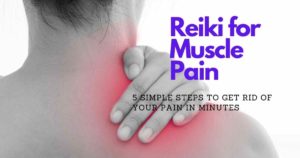Are you seeking a holistic and natural approach to pain management? Look no further than Reiki Healing. This ancient practice has been shown to provide relief for both physical and emotional problems. Whether you’re experiencing chronic pain or simply looking for alternative pain management techniques, Reiki Healing may be the solution you’ve been searching for.
Reiki Healing works by tapping into the body’s natural energy and promoting deep relaxation. By reducing stress and anxiety, this gentle therapy allows the body to focus on healing itself. And the best part? Reiki can be used alongside other medical treatments to enhance their effectiveness and provide a well-rounded approach to pain management.
Key Takeaways:
- Reiki Healing is a holistic approach to pain management.
- It promotes deep relaxation and reduces stress and anxiety.
- Reiki can be used alongside other medical treatments.
- It is a natural and gentle therapy.
- Reiki Healing focuses on tapping into the body’s natural energy.
What is Reiki Healing?
Reiki Healing is a form of energy healing that aims to unblock stagnant energy in the body. Practitioners believe that this energy, known as ki or chi, can become blocked and lead to illness or pain. During a Reiki session, the practitioner will place their hands lightly on or over specific areas of the client’s body to facilitate the transfer of healing energy. Reiki is not a replacement for medical treatments but can be used alongside them to promote relaxation, reduce pain, and enhance overall well-being.
How does Reiki Healing work?
- Practitioners believe that Reiki Healing works by channeling universal energy through the practitioner’s hands to the client.
- During a session, the practitioner will place their hands lightly on or over specific areas of the client’s body to facilitate the transfer of healing energy.
- The energy transfer is believed to remove blockages, promote relaxation, relieve pain, and stimulate the body’s natural healing processes.
Reiki techniques include centering, clearing, beaming, and extracting harmful energies.
Is Reiki Healing effective for pain relief?
Scientific research on Reiki Healing is limited but has shown promising results. Some studies have indicated that Reiki may be effective for pain and anxiety. In one study with cancer patients, Reiki was found to be more effective than rest in reducing pain. Another study with post-surgical patients found that Reiki significantly reduced pain levels. However, more research with larger sample sizes, consistently randomized groups, and standardized treatment protocols is recommended to further validate the effectiveness of Reiki therapy.
| Research Study | Findings |
|---|---|
| Study with Cancer Patients | Reiki more effective than rest in reducing pain |
| Study with Post-Surgical Patients | Reiki significantly reduced pain levels |
The Benefits of Reiki Healing for Pain Management
Reiki Healing offers numerous benefits for pain management. Research has shown that it can significantly reduce pain levels in individuals undergoing surgery, as well as lower their blood pressure, breathing rate, and anxiety. Additionally, Reiki has been found to improve mood and sleep, especially in individuals with higher levels of anxiety and depression. By promoting deep relaxation, Reiki helps the body’s natural healing process and may alleviate tension and promote pain reduction.
One of the key benefits of Reiki Healing is its ability to support the autonomic nervous system in shifting from a sympathetic-dominant state (fight-or-flight) to a parasympathetic-dominant state (rest-and-digest). This shift allows for better overall well-being and can help reduce pain and stress levels. By reducing stress and promoting relaxation, Reiki allows the body to focus on healing itself, which can be particularly beneficial for individuals dealing with chronic pain.
While Reiki is not a replacement for medical treatments, it can be used as a complementary therapy alongside other interventions. Many individuals who have received Reiki sessions have reported a reduction in pain, increased relaxation, and an improved sense of well-being. By incorporating Reiki into a pain management plan, individuals may experience enhanced pain relief and a greater overall improvement in their quality of life.
| Benefits of Reiki Healing for Pain Management | Summary |
|---|---|
| Reduces pain levels in individuals undergoing surgery | Significantly reduces pain, blood pressure, breathing rate, and anxiety |
| Improves mood and sleep | Especially beneficial for individuals with higher levels of anxiety and depression |
| Promotes deep relaxation | Alleviates tension and promotes pain reduction |
| Supports autonomic nervous system shift | From sympathetic-dominant state to parasympathetic-dominant state |
| Complementary therapy | Used alongside medical treatments for enhanced pain relief and well-being |
How Reiki Healing Works
Reiki Healing works through the transfer of universal energy from the practitioner to the client, promoting relaxation and stimulating the body’s natural healing processes. During a session, the practitioner places their hands lightly on or over specific areas of the client’s body. This transfer of healing energy is believed to remove blockages and restore the flow of energy within the body, relieving pain and promoting overall well-being.
Reiki techniques include various hand positions, such as centering, clearing, beaming, and extracting harmful energies. These techniques aim to unblock stagnant energy and facilitate the healing process. By channeling the universal energy through their hands, practitioners act as a conduit, assisting the recipient’s innate healing energy in facilitating self-healing.
The Energy Transfer Process
The energy transfer process in Reiki Healing involves the movement of healing energy from the practitioner to the client. It is believed that this energy can help remove energetic blockages, balance the body’s energy field, and promote deep relaxation. While the energy involved in Reiki cannot be measured by modern scientific techniques, many practitioners and recipients can feel its effects, such as warmth, tingling sensations, or a sense of peace and calm.
Overall, Reiki Healing works on the principle that the body has the natural ability to heal itself when in a state of balance and relaxation. By promoting the flow of healing energy and releasing blockages, Reiki can support the body’s self-healing mechanisms and provide relief from pain and stress. It is important to note that Reiki should be used as a complementary therapy alongside conventional medical treatments for optimal results.
| Reiki Techniques | Description |
|---|---|
| Centering | Practitioner focuses on grounding themselves and connecting to the universal energy. |
| Clearing | Practitioner helps to clear any negative or stagnant energy from the client’s energy field. |
| Beaming | Practitioner directs the flow of healing energy towards specific areas of the client’s body. |
| Extracting Harmful Energies | Practitioner assists in removing any harmful energies that may be affecting the client’s well-being. |
Reiki Healing and Scientific Research
Scientific research plays a crucial role in understanding the efficacy of Reiki Healing for pain management. While the body of research is limited, there have been studies that provide promising evidence for the benefits of Reiki therapy. These studies highlight the potential of Reiki to reduce pain levels and alleviate anxiety.
One notable study focused on cancer patients receiving Reiki therapy, which demonstrated that Reiki was more effective than rest alone in reducing pain. Another study involving post-surgical patients found that Reiki significantly reduced pain levels when compared to a control group.
It is important to acknowledge that further research is needed to strengthen the evidence base for Reiki Healing. Larger sample sizes, randomized controlled trials, and standardized treatment protocols are necessary to establish the effectiveness of Reiki therapy more conclusively. Despite the current limitations, these initial studies provide encouraging insights into the potential of Reiki as a complementary pain management approach.
| Study | Participants | Findings |
|---|---|---|
| Study 1 | Cancer patients | Reiki was more effective than rest alone in reducing pain. |
| Study 2 | Post-surgical patients | Reiki significantly reduced pain levels compared to a control group. |
These studies provide a foundation for further exploration of Reiki Healing and its role in pain management. While more research is needed to validate these findings and establish a clear understanding of the mechanisms behind Reiki therapy, the existing evidence suggests that Reiki may have positive effects on pain reduction and overall well-being.
Reiki Healing and Energy Medicine
Reiki Healing falls under the category of energy medicine, specifically biofield energy therapy. This approach believes that disruptions in the body’s energy field can lead to illness and pain. Reiki aims to restore the flow of energy and remove blockages through the transfer of universal energy. While the energy involved in Reiki cannot be measured by modern scientific techniques, many practitioners and recipients can feel its effects.
Understanding Biofield Energy Therapy
Biofield energy therapy encompasses various modalities that work with the body’s energy field to promote healing and well-being. Reiki is one such modality that focuses on channeling healing energy through the practitioner’s hands to the client. The energy transfer in Reiki therapy promotes relaxation, relieves pain, and aids the body’s natural healing processes.
Table: A Closer Look at Biofield Energy Therapy Modalities
| Modality | Description |
|---|---|
| Reiki Healing | Aims to unblock stagnant energy and restore the flow of healing energy in the body. |
| Therapeutic Touch | Involves the practitioner using their hands to manipulate the client’s energy field to promote healing. |
| Healing Touch | Similar to Therapeutic Touch, focuses on balancing the body’s energy system for healing purposes. |
| Qi Gong | A Chinese practice that combines movement, meditation, and breathwork to cultivate and balance the body’s energy. |
Benefits of Reiki Healing and Energy Medicine
Reiki Healing, along with other biofield energy therapies, offers a unique approach to pain management and overall well-being. By restoring the body’s energy balance, Reiki can provide relaxation, reduce pain levels, and enhance the body’s natural healing processes. It is important to note that Reiki should not replace conventional medical treatments; instead, it can be used as a complementary therapy alongside them.
The Origins and Practice of Reiki Healing
Reiki Healing, a form of energy healing, was developed by Dr. Mikau Usui in 1922. Driven by a spiritual journey, Usui discovered the Reiki energy while on Mount Kurama in Japan. He then brought this technique to the public and taught it at different levels. The practice of Reiki involves the placement of hands on or over specific areas of the client’s body, allowing for the transfer of healing energy.
There are three levels of Reiki practice, each level granting expanded abilities and practice. Students progress through these levels to deepen their understanding and connection to the Reiki energy. As they advance, practitioners gain the skills to work with others, perform distant healing, and even teach Reiki to others. The practice of Reiki is a continuous journey of personal growth and spiritual development.
The Three Levels of Reiki Practice
The three levels of Reiki practice are as follows:
- Level 1: Reiki Practitioner – At this level, practitioners learn the foundational principles of Reiki, including energy concepts, hand positions, and self-healing techniques. They focus on healing themselves and others in person.
- Level 2: Reiki Practitioner and Healer – Building upon the knowledge gained in Level 1, practitioners at this level receive additional symbols and techniques that allow them to perform distant healing and work with mental and emotional aspects of healing.
- Level 3: Reiki Master – The final level, Reiki Masters, have obtained advanced knowledge and skills. They can attune others to Reiki energy, teach Reiki classes, and continue their own spiritual growth and development.
Reiki Healing is a practice that brings together spirituality and healing, offering individuals a pathway to tap into their own innate healing abilities and promote overall well-being.
| Level | Description |
|---|---|
| Level 1: Reiki Practitioner | Focus on foundational principles of Reiki, including energy concepts, hand positions, and self-healing techniques. Can perform in-person healing. |
| Level 2: Reiki Practitioner and Healer | Receive additional symbols and techniques for distant healing and working with mental and emotional aspects of healing. |
| Level 3: Reiki Master | Have advanced knowledge and skills, can attune others to Reiki energy, teach Reiki classes, and continue personal spiritual development. |
Reiki Healing and Its Reported Health Benefits
Reiki Healing has been reported to offer a range of health benefits for individuals seeking natural pain management and emotional well-being. Many recipients of Reiki sessions have experienced deep relaxation, reduced pain levels, and an overall sense of improved well-being. Reiki has often been used as a complementary therapy for chronic pain, anxiety, and depression.
For individuals suffering from chronic pain, Reiki Healing has been known to provide relief and promote relaxation. Through the transfer of healing energy, Reiki aims to alleviate tension and stimulate the body’s innate healing processes. It is important to note that Reiki should not replace medical treatments but can be used alongside them to enhance pain management.
In terms of emotional well-being, Reiki Healing has shown promise in reducing anxiety and depression. Many individuals have reported a sense of calm and tranquility after receiving Reiki sessions, which can contribute to improved mood and overall mental health. Reiki’s ability to promote deep relaxation may also help individuals cope with stress and improve their overall quality of life.
| Reported Health Benefits of Reiki Healing |
|---|
| Relaxation |
| Reduced pain levels |
| Relief from anxiety and depression |
| Improved overall well-being |
| Sense of deep relaxation |
While scientific research on Reiki Healing is limited, the reported health benefits from individuals who have undergone Reiki sessions cannot be ignored. It is important to approach Reiki as a complementary therapy, and individuals should consult with their healthcare providers to determine the best course of treatment for their specific conditions.
Is Reiki Healing Effective?
The effectiveness of Reiki Healing is a topic of debate within the scientific community. While some studies have shown positive results, others argue that there is insufficient evidence to support the clinical benefit of Reiki therapy. It is important to consider that research on Reiki is limited by factors such as small sample sizes, lack of peer review, and absence of control groups. More high-quality research with rigorous study designs is needed to further investigate the efficacy of Reiki therapy.
Despite the lack of extensive scientific evidence, many individuals who have received Reiki sessions report positive outcomes. They often describe feelings of deep relaxation, reduced pain levels, and an overall sense of improved well-being. Reiki Healing is often used as a complementary therapy alongside conventional medical treatments, helping individuals to manage pain, anxiety, and stress.
While it’s important to approach Reiki Healing with an open mind, it should not replace medical treatments. Reiki therapy should be seen as a holistic approach to pain management that aims to promote relaxation, reduce pain, and enhance overall well-being. Consulting with a qualified Reiki practitioner and discussing its potential benefits and limitations can help individuals make an informed decision about incorporating Reiki into their pain management plan.
| Pros of Reiki Healing | Cons of Reiki Healing |
|---|---|
|
|
Conclusion
Reiki Healing offers a holistic approach to pain management, providing potential benefits for individuals seeking relief. While scientific research on Reiki is limited, anecdotal evidence from those who have experienced Reiki sessions supports its effectiveness in reducing pain, anxiety, and stress.
It is important to note that Reiki should be used alongside conventional medical treatments and not as a substitute. By promoting relaxation and supporting the body’s natural healing processes, Reiki can complement existing medical therapies to enhance overall well-being. However, further research with rigorous study designs is needed to better understand the mechanisms and effectiveness of Reiki Healing.
In conclusion, Reiki Healing shows promise as a complementary therapy for pain management. While scientific evidence is still emerging, the reported benefits and experiences of individuals who have received Reiki sessions highlight its potential in reducing pain and promoting relaxation. As the field of energy medicine continues to evolve, it is worth considering Reiki as an additional tool to support overall health and wellness.




